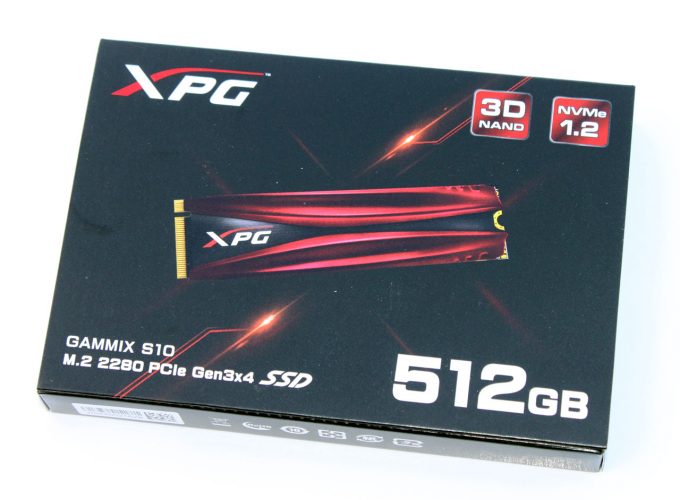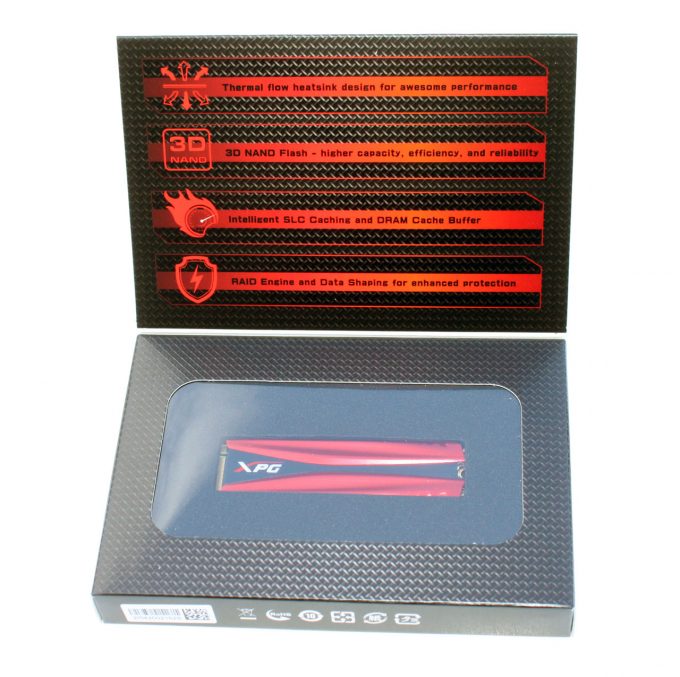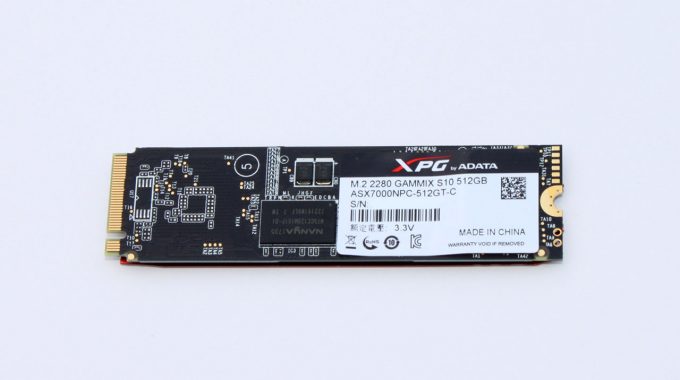- Qualcomm Launches Snapdragon 4 Gen 2 Mobile Platform
- AMD Launches Ryzen PRO 7000 Series Mobile & Desktop Platform
- Intel Launches Sleek Single-Slot Arc Pro A60 Workstation Graphics Card
- NVIDIA Announces Latest Ada Lovelace Additions: GeForce RTX 4060 Ti & RTX 4060
- Maxon Redshift With AMD Radeon GPU Rendering Support Now Available
ADATA GAMMIX S10 512GB SSD Review: Affordable M.2 NVMe Performance

Budget SSDs are not hard to find, but the price shouldn’t be the sole deciding factor. SATA SSDs might have been relegated to the bargain basement, but ultra-cheap “SATA Only” M.2 drives remain a hidden minefield that litters the budget M.2 marketplace. ADATA’s XPG S10 GAMMIX comes to the rescue, offering high-end NVMe performance at a budget price.
Page 1 – Introduction; Sizing Up the ADATA GAMMIX S10 M.2 SSD
You’ve probably heard it before: storage is the slowest part of a computer. A typical spinning hard drive operates with around 12 milliseconds of random access latency, basically the time required to lookup or write data someplace on the drive. It seems absurd to consider 0.012 of a second “slow”, until realizing one that second in real time is equivalent to 4,000,000,000 CPU cycles on a 4GHz processor. So whether opening a file or launching a program in the span of 12ms we are still talking about 48,000,000 cycles of the processor waiting for the first bits of that new data it needs to reach memory.
These days not only do modern processors reach even higher to 5GHz but they typically include four to eight (or even more) individual cores working in tandem, all while there often remains only the single spinning hard drive trying to host the OS, applications, and all-important games.
Rather than continuously throw overly large numbers around, flash storage devices have adopted IOPS as the metric to show off just how many Input/output Operations Per Second a solid-state drive can achieve. Old spinning rust is lucky to reach just 100 IOPS but can quickly drop to single digits under a punishing randomized workload. By comparison flash drives can reach six digits, and even better do not care too much if the workload is random or sequential in nature.
ADATA’s XPS GAMMIX S10 is an M.2 NVMe solid-state drive promising better-than-SATA SSD performance without sacrificing the affordable price. ADATA is one of the most prolific brands in the SSD market right now, so it is worth noting that the SX7000 model happens to be the same exact drive as the S10 minus the styled heatspreader – and it might be found for less. During the course of this review the S10 has been repeatedly selling at 23 cents per gigabyte from several online retailers, offering a value proposition close enough to SATA SSDs to entice the would-be SATA SSD buyer to choose the higher performance and M.2 NVMe capability.
Interestingly the SM2260 controller and specific Micron 384Gb 32-layer TLC NAND used on the GAMMIX S10 is the same combination of hardware found on Intel’s 600p M.2 drives which retail for much more. For the moment regular SATA SSDs can easily be found below $80 for 512GB capacities, but these tend to sacrifice the DRAM cache to attain those prices. The loss of a DRAM cache will negatively affect performance consistency as well as the overall endurance of the NAND flash itself. This keeps the respectable SATA SSDs priced closer to $100, but ADATA is hoping to woo over potential buyers with its aggressively priced M.2 offerings that are not performance bottlenecked by the SATA interface.
| 128GB | 256GB | 512GB | 1TB | |
| Form Factor | M.2 2280 | |||
| Interface | PCIe 3.0 x4, NVMe 1.2 | |||
| Controller | Silicon Motion SM2260 | |||
| DRAM Cache | Yes | |||
| Flash NAND | Micron 3D TLC | |||
| SLC Fast-Write Cache | Yes (dynamically allocated) | |||
| Write Endurance | 80TB | 160TB | 320TB | 640TB |
| Sequential Read | 660 MB/s | 1,370 MB/s | 1,750 MB/s | |
| Sequential Write | 450 MB/s | 820 MB/s | 860 MB/s | 850 MB/s |
| 4K Random Read | 35K IOPS | 70K IOPS | 130K IOPS | |
| 4K Random Write | 95K IOPS | 130K IOPS | 140K IOPS | |
| Warranty | Five Years | |||
| Street Price | $45 | $80 | $135 | $440 |
The GAMMIX S10 naturally offers the same SLC fast-write caching as the ADATA SU900 TLC SSD we reviewed and most other TLC NAND based drives. Instead of a fixed allocation, the drive will dynamically adjust the SLC fast-cache size based on overrun of the SSD’s DRAM cache, though the maximum size of the fast-write cache is not given. The DRAM cache size itself is also not listed, although it is likely that 512MB of Nanya DDR3 cache is present on the 512GB model with smaller capacity drives likely utilizing a 256MB DRAM buffer.
By now it should go without saying, but performance of models with less than 512GB capacity will be negatively affected as there simply will not be enough NAND dies for the controller to spread the load across. If considering a 128GB model due to price (regardless of the manufacturer or model in question, even) it may be worth considering purchasing a cheaper model at the next larger capacity. SSDs extract much of their performance from parallelism, by writing to multiple NAND blocks or reading from multiple pages concurrently, and after too many NAND die are stripped away to reduce capacity, the resulting performance can wind up being even worse than what the reduced specifications show.
ADATA offers a download of Acronis True Image HD for easy data migration use with its SSDs. Also available is ADATA’s SSD Toolbox software which provides firmware updates, secure erase functionality, OS optimization, drive status information, and of course diagnostic options. It also provides a quick “Total Bytes Written” indicator to easily satiate curiosity and monitor total wear of the SSD without having to wade through the drive’s SMART data to find it.
| SSD Test System | |
| Processor | Intel Core i7-4771 @ 3.7GHz |
| Motherboard | ASUS Z97-A – BIOS 2801 |
| Memory | Crucial Ballistix 8GBx4 DDR3-1600 |
| Graphics | EVGA GeForce GTX 750 Ti SC |
| Audio | Onboard |
| Storage | ADATA SP550 480GB (SATA) ADATA XPG GAMMIX S10 512GB (PCIe) ADATA Ultimate SU800 512GB (SATA) ADATA Ultimate SU900 512GB (SATA) Crucial BX200 240GB (SATA) Crucial m4 (C400) 256GB (SATA) Crucial MX300 525GB (SATA) Intel 520 240GB (SATA) Intel 730 240GB (SATA) Kingston Predator 240GB (PCIe) Samsung 950 Pro 512GB (NVMe PCIe) Transcend SSD360S (SATA) |
| Power Supply | BitFenix Fury 650W |
| Chassis | Cooler Master HAF 932 |
| Cooling | Noctua NH-D14 |
| Et cetera | Windows 10 Pro x64 |
To ensure all drives have fair representation regardless of capacity in our testing, we use IOMeter to conduct continuous file writes beyond the rated capacity of each SSD. This will make sure every block has been written to at least once, including the unaddressable spare area present on all solid-state drives, ensuring all drives begin testing in a normalized “dirty” state.
SATA drives are tested on an Intel 6Gbps SATA port, while PCIe cards will use the PCIe Gen 3 x8 slot to the processor. M.2 drives will make use of an NVMe compatible PCIe adapter card in this same slot to bypass the M.2 x2 interface bottleneck (some motherboards only offer an x2 lane M.2 port), allowing drives to utilize the maximum bandwidth (PCIe Gen 3 x4) that the M.2 interface supports. Where applicable, we will ensure M.2 drives are using the NVM Express protocol.
The test system’s processor has had Intel’s Speedstep and Turbo Boost functionality disabled, and all cores are locked to the same 3.7GHz frequency in order to ensure maximum consistency between test runs. The goal of our testing is to determine how drives compare to one another and with SSDs even one second can mean the difference in ranking results.
Support our efforts! With ad revenue at an all-time low for written websites, we're relying more than ever on reader support to help us continue putting so much effort into this type of content. You can support us by becoming a Patron, or by using our Amazon shopping affiliate links listed through our articles. Thanks for your support!















